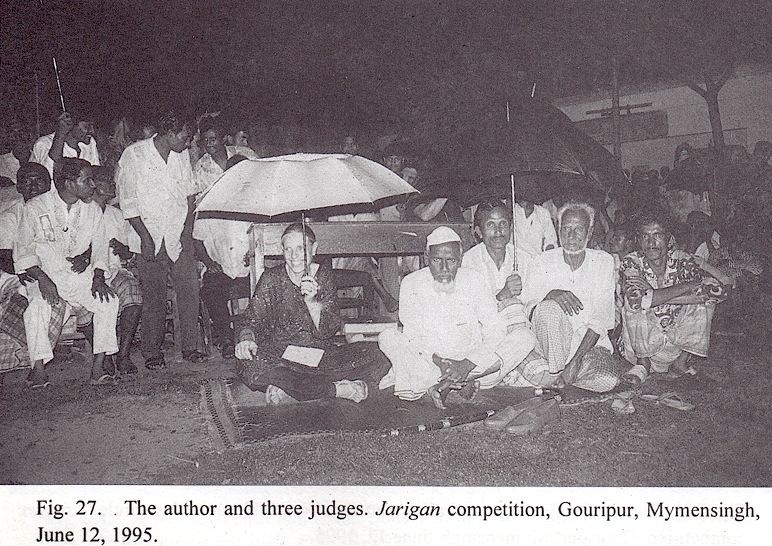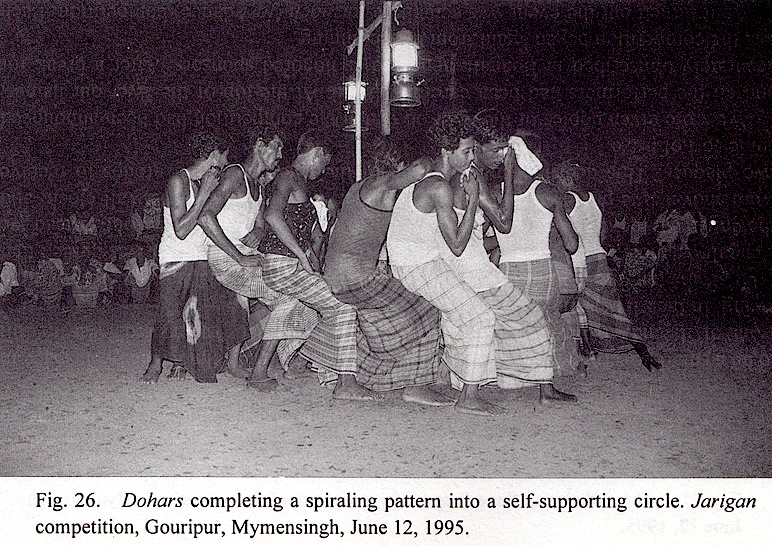
Mary Frances Dunham’s work on jarigan songs.
In 1960, Mary Frances Dunham , New York-based music and classical languages scholar who studied at Harvard and Columbia universities, went to Dhaka (spelt Dacca in those days), accompanying her husband Daniel C. Dunham (died 2000), who was designing a school of architecture for the then Pakistani Government under a USAID programme (what now stands as the famous Bangladesh University of Engineering and Technology, BUET). Mary met the poet and folk music collector Jasimuddin (1903-1976) and ‘by accident’ she came to know about narrative song form, jarigan. Jasimuddin had transcribed twenty full length jarigan songs and written a long introduction which he wanted to publish as a book, but he also wished to include Western musical notation for the songs for wider outreach. He asked Mary if she could help. She was hesitant as ‘the language, literature and music of Bengal was still new’ to her. ‘Jasimuddin offered encouragement and assured me that some day I would be grateful for the effort I was making,’ she writes in the Preface to her 1997 book.
Jasimuddin’s book was first published in 1968; then the second edition came out in 2003. For the songs, Jasimuddin had got Meghu Boyati of Faridpur (coincidentally, our 2008 singer Jainuddin Boyati’s guru or ustad) to Dhaka and recorded him on a tape recorder. Mary listened to the recordings again and again and notated them. In his 1968 book Jasimuddin profusely thanks her for her contribution. ‘সেই টেপ বার বার বাজাইয়া মিসেস ডানহাম এই গানগুলির স্বরলিপি তৈরী করিয়াছেন।‘
 Photo taken from Mary Frances Dunham’s book, Jarigan: Muslim Epic Songs of Bangladesh
Photo taken from Mary Frances Dunham’s book, Jarigan: Muslim Epic Songs of Bangladesh
After returning to the US in 1967, Mary Frances Dunham joined Columbia University for a Masters programme and wrote her final thesis on jarigan, in 1972. She would write and lecture on the subject, but a wish to ‘finish’ an unfinished project must have stayed with her, for when she came on a visit to Dhaka in 1993, she got talking with her friends about her work of more than twenty years ago. The idea to follow up on past research and do further field work began to germinate. In 1995 Mary returned with a grant from Ford Foundation to do field work on jarigan and from her past and current work came out her book, Jarigan: Muslim Epic Songs of Bangladesh, in 1997, published by UPL, Dhaka. It was accompanied by an audio cassette (now available as CD) of Jasimuddin and Mary’s own recordings.
So far what we had with us was a copy of this book and an audio cassette, but we were very keen to contact Mary. After several years of trying and to our great delight, we have now (in 2014) been able to establish contact with her.
Mary Frances Dunham has very generously given us digitized audio files for the recordings which come with her book, for uploading on our website. None of these recordings may be commercially used without her written consent and even non-commercial users must fully acknowledge her (or Jasimuddin, where appropriate) and UPL as the source of these recordings. Mary Frances Dunham can be contacted through her publishers UPL, Dhaka or through this website. Her almost 350-page book is a detailed study on Jarigan and anyone interested in the subject should have a copy. Her papers and other recordings are being archived at Columbia University (http://findingaids.cul.columbia.edu/ead/nnc-rb/ldpd_10666979/summary).
After spending eight years in Shanghai, Mary Frances Dunham has now returned to live in New York.
Related links
Mary Frances Dunham essay, published by University of Michigan in 1975, in a collection of papers from a conference on Bengal Studies held earlier, in 1973. Pages 85-94.
http://files.eric.ed.gov/fulltext/ED124945.pdf
James Walden on working with fellow architects Dik Vroohen and Dan Dunham in Dhaka in the 1960s.
http://archrecord.construction.com/news/2012/03/Memoir-My-Dacca-Days.asp
________________________________
These soundtracks are from the accompanying audio cassette to Jarigan: Muslim Epic Songs of Bangladesh by Mary Frances Dunham. The notes are taken from the same book.
1. “[A!] bahire thakiya ghora…”; a jarigan song sung by Meghu Boyati of Faridpur. Recorded by Jasimuddin in Dhaka, 1964.
2. “[A hai are] bolo Allahr nam…”; a jarigan song including a bandana and two verses of the narrative, sung by Meghu Boyati of Faridpur. Recorded by Jasimuddin in Dhaka, 1964.
3. “Allah prothom selam bheji…”; a bandana sung by Mohammad Ali Akbar Miah and chorus of four dohars, recorded by Mary Frances Dunham in Shuhilpur Village, Brahmanbaria, 1995.
4. “Allah, tomai daki…”; a murshidi gan sung by Abbas Ali Bhashan, recorded by Mary Frances Dunham in Poiratala Village, Brahmanbaria, 1995.
5. “Amar alir shontan…”; a jarigan song sung by Mohammad Ali Akbar Miah and chorus of four dohars, recorded by Mary Frances Dunham in Shuhilpur Village, Brahmanbaria, 1995.
6. “[A!] probhat kale kokilo…”; a dhuagan song, sung by Meghu Boyati of Faridpur, recorded by Jasimuddin in Dhaka, 1964.
7. “[Are] nache re [re] buira nache…”; a dhuagan song, sung by Meghu Boyati of Faridpur, recorded by Jasimuddin in Dhaka, 1964.
8. “Banu [re], Joynal shopilam tor hate…”; a jarigan song sung by Hatim Uddin Sarkar of Gouripur, Mymensingh, recorded by Mary Frances Dunham in Gouripur, 1995.
9. “[O!] Allah bolo [re], mono [re]…”; a jarigan song, sung by Meghu Boyati of Faridpur. Recorded by Jasimuddin in Dhaka, 1964.
10. “[Ore] darun Ejid…”; a jarigan song, sung by Meghu Boyati of Faridpur. Recorded by Jasimuddin in Dhaka, 1964.
11. “Shonen amar koi, shrotagon…”; a jarigan song sung by a boyati and chorus of about twenty dohar-dancers during a jarigan competition in a village near Gouripur, Mymensingh, recorded by Mary Frances Dunham, 1995. Track 16 contains a longer recording of this performance.
12. “Tumi ga tolo, Sokhina…”; a dhuagan song sung by Meghu Boyati of Faridpur. Recorded by Jasimuddin in Dhaka, 1964.
13. “Udashi [go] hoilo Hasan…”; a jarigan song, recorded recorded by Mary Frances Dunham in Dhaka, 1967. The singer’s name is unknown.
14. “[Ore] Mohammad Hanifa…”; a portion of a dhuagan song sung by Meghu Boyati of Faridpur. Recorded by Jasimuddin in Dhaka, 1964. The text is about Hosein’s surviving son, Joynal, and his greeting by his uncle, Hanifa.
15. “[O!] shikar kore…”; a portion of a dhuagan song sung by Meghu Boyati of Faridpur. Recorded by Jasimuddin in Dhaka, 1964. The song is about poisoning of Hasan.
 Photo taken from Mary Frances Dunham’s book, Jarigan: Muslim Epic Songs of Bangladesh
Photo taken from Mary Frances Dunham’s book, Jarigan: Muslim Epic Songs of Bangladesh
16. A portion of a jarigan group performing in a jarigan song-dance competition in Gouripur, Mymensingh, June 12, 1995. The story here precedes the battle of Karbala: Muslem’s letter to Hosein, the treachery of Abdul Ziad, and Hosein’s setting out for kufa. The passage ends with the measured swishing sound of the dohar’s anklets as they close into a circle in which each dohar is supported on the lap of the one behind him. The audience applauds.
17. Women’s majlis. This majlis took place on June 2, 1995, the second day of Muharram of that year. It was conducted in Urdu. The recording begins with the climax of the majlis sermon., followed by several hymns sung by four young women as leaders. They are joined by the rest of the congregation, about thirty women in all. The start of chest-beating is clearly audible after the first hymn. A member of the audience can be heard explaining the themes of Muharram to Mrs Dunham.
18. Men’s Muharram singing at the Gorpara Imama bara in the evening, June 9, 1995. The singing is preceded by the sounds of the crowd gathering, of a flute, and of drumming accompanying the chanting of “Hosein!”. About ten men sing Muharram songs in Bengali accompanied by a harmonium. Part of the songs are omitted in the recording in order to show several examples.
- Letter from Mainadal (At the time of Covid-19)
- Sound Expeditions : Recording Tarak Das Baul in Kenduli
- Letters from Mainadal
- Raka Banerjee – Songs from the Tea Gardens
- Muhammad Ali Ahsan’s recordings, আলীর ডাইরি
- Surojit Sen writes about his experience of engaging with fakiri songs
- Debdas Baul on Bhaskar Bhattacharjya, documentary filmmaker, who worked on the bauls.
- Video extracts from Ruchir Joshi’s 1992 film on the bauls, Egaro Mile (Eleven Miles) and his letter about making the film
- Soumya Chakravarti account of recording folk singer Anantabala Baishnabi in 1968.
- Arnold Bake’s 1932-33 films and audio recordings from Bengal
- Interview with Amy Catlin Jairazbhoy
- Extracts from Khaled Chowdhury’s interview
